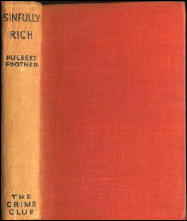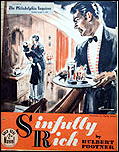Sun 4 Jul 2010
HULBERT FOOTNER – Sinfully Rich. Harper & Brothers, hardcover, 1940. Reprinted as a Philadelphia Inquirer “Gold Seal Novel”: August 3, 1941. Hardcover reprint: Books Inc., 1944. British edition: Collins Crime Club, hc, 1940.
Hulbert Footner was a Canadian-American writer who, nearing the age of forty, began publishing mystery tales about the time World War One ended.

He soon made a good name for himself in the field, particularly with his tales of an early female detective, Madame Rosika Storey. (Madame Storey is who he is remembered for today, when he is remembered.)
Many of his novels and stories are more accurately characterized as thrillers; and even his tales of putative detection seem more “mystery” than detection, with the author not paying scrupulous attention to the fair play concept (allowing the reader the chance to solve the mystery for him/herself through deciphering clues fairly provided by the author).
Still, Footner’s works often have “zip” and are entertaining enough, just not necessarily mentally over-rigorous. A good example of his style is one of his later works, Sinfully Rich (1940).
In Sinfully Rich, a sixty-seven year old millionaire’s widow who has been living it up in New York City smart society after the death of her tightfisted husband is found dead after a big night, all her jewels missing.
The police and medical examiners think she died naturally and then was robbed, but ace journalist Mike Speedon (who is to inherit a modest sum of $100,000 dollars from the “old dame”) shows the experts what for (journalists — what don’t they know?). He proves the millionairess was murdered (disappointingly so, as the putatively amazing murder method is taken lock, stock and barrel from Dorothy L. Sayers and Unnatural Death, published a dozen years earlier).
In the classical British manner there is are two wills, a missing nephew, a dubious lawyer, a scheming gigolo and household full of suspicious employees and servants (personal secretary, personal maid, first housemaid, butler and “second man”).
What more could a mystery fan ask for? Well, a more clever plot, perhaps, but maybe that is being uncharitable on my part. There were many, many mystery novels published in those days, and one cannot reasonably expect sheer brilliance from all of them.

What is most enjoyable about the book is the interactions of the characters up to the resolution of the mystery. Footner casts a wryly amused glance over the foibles of the wealthy, who have, seemingly, a great deal of time and money to burn.
Footner treats his readers to glimpses of the high life, US version, but he also encourages them to mock what they see, through the focal character of the cynical, clever, manly reporter, such a classic figure in American film and literature from this period. If it’s rather like a watered-down Dashiell Hammett highball (The Thinner Man, say), at least it goes down smoothly, with no unpleasant aftertaste.
There is investigation, but no really satisfying ratiocinative process. (I was rather reminded in this respect of the British novelist J. S. Fletcher, whose mystery novels probably were more popular during the Golden Age in the United States than they were in his native Britain.)
Because there really isn’t fair play, Footner is able to maintain until the end of the novel suspense concerning the question “Whodunit?”; yet some of the fun, for me anyway, is lost.
If, as Robert Frost opined, free verse is like playing tennis without a net, so is a mystery that does not practice fair play. You can still enjoy it, but you feel a bit cheated! Still, I’ve read far worse mysteries from the period than Sinfully Rich. (See my Carolyn Wells reviews!)
Editorial Comment: A list of the “Gold Seal” novels published in the Sunday Philadelphia Inquirer (mid-1930s to late 1940s) can be found online here. Many of them were mysteries; others appear to be straight romances.
July 4th, 2010 at 10:00 pm
I’ve read a little Footner and enjoyed him on the same level and in the same way Curt describes. If his work holds up today at all it is thanks to some playful writing more than the detective element.
And for some reason I always associate him with J.S. Fletcher too.
Several Madame Storey books can be read on-line at Project Gutenberg Canada.
July 4th, 2010 at 11:11 pm
Some of the Storey stories I read in the pulp magazines, but none of the books. Some are novels and others are collections.
On the basis of Curt’s review, I’d say that SINFULLY RICH would be fun to read. I don’t always mind if a mystery story isn’t a “fair play” one. I have more problems, I’d have to add, with those that pretend that they are, and aren’t.
July 5th, 2010 at 12:10 am
Barzun and Taylor describe Footner’s serious work in the “stoic-sardonic” vein, whatever that means. They list his series sleuths as young B. Enderby, Pickwickian Amos Lee Mappin, and Madame Storey but the only one of his novels they deal with is his last, a Mappin with an obituary appreciation by Christopher Morley (wouldn’t mind reading that).
Haycraft only mentions him in relation to Morley being a fan of Madame Storey and Mappin a popular sleuth. On the whole he is somewhat dismissive despite Footner’s success. I think Robert Sampson deals with some of the Madame Storey tales in YESTERDAY’S FACES but I would have to check.
Footner, like J.S. Fletcher, seems to have been a once highly successful and popular writer virtually forgotten today and largely ignored by genre critics in his time. Seemingly no one but his readers loved him. And yet most readers familiar with the classical period will know the name even if they have never read one of his books or stories. Though as Curt points out that may be something that should be corrected.
Steve
I agree wholeheartedly about the fair play detective story. While it may be the highest form of one branch of the detective story it is by no means the only entertaining form of mystery fiction from that era. Sometimes playing fair with the reader is merely a matter of entertaining him so he doesn’t care if a bit of wool gets pulled over his eyes or the solution gets pulled out of a top hat without showing us how the trick was done.
That said I suspect relatively few of us would really enjoy Footner, but thanks to Curt we know one of the titles to look for when we do go beyond the handful of Storey tales we are familiar with.
July 5th, 2010 at 2:23 am
What got me interested a bit in Footner was that all his novels seem to have been published in Britain in the 20s and 30s, mostly by the Collins Crime Club, often in paperback editions as well. He seems to have been quite popular with British mystery readers. I think the milieu perhaps has something to do with it. In some ways, Sinfully Rich could be British (indeed, there are British characters). However, there’s a brash American reporter in the mix to remind us where we really are.
Many of his later books are Mappins, though Sinfully Rich is non-series. He seems to have dropped Madame Story in the mid-1930s, for reasons unknown. Maybe they were too obviously derivative of the Holmes format.
I enjoyed Sinfully Rich reasonably well. It moves quickly and the characters are lightly amusing. It’s really “mystery” more than fair play detection, but that’s okay. I’d rather read something like this than Mary Rinehart or Mignon Eberhart from the same period (1930s), to be honest.
July 5th, 2010 at 2:39 am
Just why one writer appeals in one country or another is often a mystery. Peter Cheyney never did really make it here in the States while he was huge in England and France, and while I don’t know that J.S. Fletcher was more popular here than in England, I do know he was Woodrow Wilson’s favorite. In Footner’s case, he was at least Canadian — maybe that had something to do with his British appeal.
I was surprised to read once that Omar Khayaam, virtually the only Arab poet most Westerners can name, was considered a very minor poet in his own culture and better known as a mathematician. For that matter I always find it amusing that the dense and dark Dostoyevsky was — in his own time — considered to be the Russian equivalent of a pulp novelist by most critics.
But in Footner’s case it probably had more to do with his style which was much closer to the British mystery novel than the American even with the occasional brash journalist thrown in. In either case he is well worth a read for anyone who enjoys the form.
July 5th, 2010 at 6:03 pm
There are some brief notes on Footner at my web site:
http://mikegrost.com/unalign.htm#Footner
Excerpt: “Amos Lee Mappin stars in “The Murder That Had Everything” (1939), which is something of a guilty pleasure. This good naturedly trashy tale of wealthy society women and the young male fortune hunters who prey on them is a lot more entertaining than it has a right to be. Much of the detection is in the Gaboriau tradition, of discovering clues left at a crime scene, and using them to reconstruct the events of the murder. There is a good deal of architectural interest in the apartment occupied by the victim (Chapters 5 – 6); creative buildings were a Golden Age specialty. Also architectural: there is also a nice piece of detection (end of Chapter 4 and Chapter 5), where the hero tracks down the location of the victim’s apartment.
The book shows affinities with the Van Dine school, at least superficially, in its genius amateur detective, its New York City upper crust setting, and its detailed Golden Age style storytelling of a murder investigation.
July 5th, 2010 at 7:13 pm
Mike, the main occupational groups of men in Sinfully Rich seemed to be:
1. Millionaire
2. Butler
3. Gigolo (these guys seem to work hard for the money)
4. Newspaper Reporter
5. Dumb Cop
July 5th, 2010 at 8:38 pm
Curt, thanks for sending me this review. I’ve learned a lot from both it and comments that have been posted. I’ll have to add Footner to a long list of authors whose work I want to read more of. Even the Madame Storey stories, which I’ll have to read again. I don’t think I appreciated them as much at the time as I would now.
— Steve